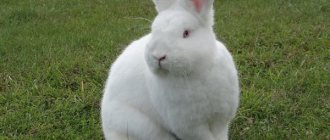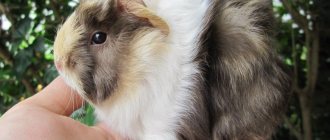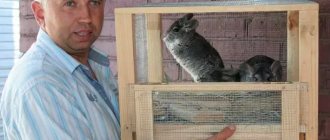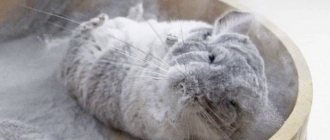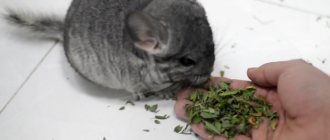Today, chinchilla breeding as a home business is a type of entrepreneurship that has no competitors. Many farmers are interested in raising chinchillas; they ask questions: is it profitable to breed chinchillas, what is needed for business, where to start planning, how to organize the sale of products. Answers to these questions, as well as reviews from experienced entrepreneurs, can be found in this article.
Chinchilla breeding as a business
There are practically no own chinchilla farms in the Russian Federation. Sewing factories purchase two-thirds of their raw materials abroad, and the quality of the fur is often not the best. All this allows us to talk about the prospects of the chinchilla breeding business.
Profit from breeding these animals can come from several sources:
- sale of meat;
- sale of fur;
- trading of breeding animals at auctions;
- cooperation with shops and poultry markets.
Chinchilla meat is not as in demand as nutria or rabbit meat. However, the product is quite edible and is considered dietary.
It is advisable to eat chinchilla meat for serious diagnoses:
- oncology (neoplasms);
- lung diseases;
- memory problems.
The animal's meat is served in expensive restaurants and added to exotic dishes. All this expands potential sales channels for the product.
Trading valuable fur will provide a stable profit. Many farmers enter into long-term cooperation agreements with sewing factories and ateliers.
Sales of products
Sales channels
Sales of products are possible in three directions:
- breeding animals to other farms;
- skins in studios and factories, as well as at auctions;
- dietary meat can be sold by advertisement or delivered to restaurants;
- small individuals to pet stores.
Beginning entrepreneurs and farmers whose production is constantly growing may need advertising. For these purposes you can use:
- Internet;
- leaflets;
- pet stores.
Growing chinchillas - advantages and disadvantages of the project
The main advantage of a business idea for growing chinchillas is a wide market against the backdrop of low competition.
Additional benefits of breeding chinchillas for subsequent sale:
- rodents are undemanding in care, maintenance and nutrition; large-scale investments in equipment are not needed to set up a farm;
- high profitability threshold - on average, keeping one rodent will cost a farmer 1,500 rubles plus the purchase of young animals. The amount from its sale is several times more than the investment; fast payback period for the project;
- chinchillas reproduce quickly and suffer little illness;
- to legalize your business, you don’t have to collect a lot of documents.
Minuses:
- lack of demand;
- risks of livestock mortality.
Food is tough and juicy
Juicy foods include tree fruits, vegetables, berries, twigs, and herbs. These products contain many vitamins necessary for the proper development of your beloved pet. In the fall, he will happily gnaw on vegetables, fruits and dried fruits. It is also useful to collect chicory, raspberry or spinach herbs.
It is not recommended to give other herbs; the consequences are unknown. It is forbidden to include cabbage in the diet; it causes stomach fermentation. Some veterinarians also do not advise giving your pet a lot of carrots; one ring of dried root vegetables per week will be enough. In order to please your pet with both healthy and tasty food, you can give twigs of apple, acacia, birch or oak. These supplements will improve the chinchilla's metabolism by saturating the body with tannins.
How to start a chinchilla farming business - step by step plan
First of all, draw up a business plan for your project.
Include the following points in the document:
- Summary of the project, including market analysis - find out if there are similar farms in the region, study the demand for animals. Think through your benefits;
- Organizational and production plan - selection of premises, purchase of equipment, food, purchase of young animals, registration of business and collection of permits;
- Financial plan - cost estimate, profit forecast, assessment of profitability and payback period of investments;
- Marketing plan - advertising, description of sales channels;
- Analysis of possible risks.
Useful properties of meat
It has long been known that not only chinchilla fur is of great value. Some farmers prefer to raise individuals only for the purpose of obtaining meat products. These animals have tender, low-calorie meat, which is in demand among connoisseurs, as well as people with certain diseases.
Chinchilla meat is consumed by patients with sclerosis of various forms, as well as to relieve the symptoms of tuberculosis. This dietary product is in high demand among people with cancer, because rodent meat has healing properties, and the components included in its composition prevent the active development of tumors.
Only healthy adults are used for meat
Market analysis
The domestic sales market is a fertile niche for chinchilla farm owners. The business has become widespread in Europe and is thriving despite the competition. In our country the niche is still free. If you manage to get high quality fur, there will be no problems with its sale. One skin is valued more expensive than sable or mink.
The following business concepts deserve attention:
- raising elite breeds of animals. To do this, you do not need to have a large livestock - it is enough to purchase 10 -15 individuals and start breeding them;
- sale for meat - sales through restaurants will provide high income;
- fur trade - this requires 200-300 individuals. Most likely you will need an employee. Don’t skimp on your chinchillas’ food; provide the animals with a place to swim and play—this way the fur will be of better quality.
Incentives for new partners
- Our company has a system for encouraging newcomers: we are pleased to offer beginning breeders a free monthly supply of food, bedding and teething stone.
- We also have another bonus when collaborating: you will be able to purchase food and accessories at manufacturer prices.
Where to buy a chinchilla in Moscow?
If you decide to start breeding chinchillas, you have one question: where to buy them? The recommendation in this case is very simple - you should cooperate only with trusted farms or breeders. There are not so many reliable producers, and evaluating them is quite simple - you need to inspect the breeding site with your own eyes.
This coming weekend we are happy to host everyone who wants to organize their own profitable business. This is very easy to do - dial 89858707117 and arrange a meeting. You can take video and audio equipment with you, and our staff will be happy to give you advice.
If for some reason you cannot come on your own, we are ready to arrange delivery from our chinchilla nursery to the address you specified.
We cooperate with individuals and legal entities. You can pay for your order in any convenient way: using cash and non-cash payments, as well as using the WebMoney and Yandex money systems.
Best regards, Sergey Sergeevich.
Registration of a chinchilla farm
Any business starts with legalization of activities. Tax evasion entails administrative liability and large fines. The optimal legal status for a chinchilla farm will be a personal subsidiary plot (LPH). In this case, the farmer is exempt from tax payments.
As the business develops and profits increase, individual entrepreneur status will be required. In this case, the farm is registered with the tax service. Select the simplified tax system Income as the type of taxation. In this case, the entrepreneur pays 6% of the proceeds to the state every month.
Note! In addition to obtaining a certificate of registration and tax registration, in order to breed and sell chinchillas you must register with the veterinary service of your city or region.
Additionally, you will need paper confirming the ownership of the premises where the farm is located. There is no need to obtain a license for this type of activity.
Vitamins
Animals obtain most of their vitamins and minerals from food. However, during winter or periods of illness, chinchillas need to receive additional amounts of nutrients. For normal development of the musculoskeletal and nervous systems, rodents must receive B vitamins, which are contained in special powder complexes or drops.
Sick individuals, babies and pregnant females need additional vitamin intake
In early spring, ascorbic acid will help compensate for the lack of vitamin C
When purchasing it at a pharmacy, please note that the drug should not contain flavorings, glucose or flavoring additives
How to choose a room for breeding chinchillas for fur
Chinchillas are one of the most undemanding animals in terms of living conditions. But the health of the animals, the quality of meat and fur directly depends on the correct choice of premises.
Basic requirements for breeding chinchillas for fur or meat:
- usable area: choose 1 square meter per 3 individuals;
- optimal temperature is 19-20 degrees;
- air humidity - no more than 60%;
- the place where the animals are kept must be kept clean;
- minimum bright light, drafts and loud sounds.
At least once a week, do general cleaning and ventilate the chinchillas’ place of residence. If care is not taken care of, fungus and mold appear.
Advice! If the territory allows, locate the farm remotely from residential premises and outbuildings.
What foods should chinchillas not eat?
To avoid mistakes in planning your pet’s diet, be sure to study the list of foods that should not be fed to your chinchilla.
- meat;
- salted, smoked, spicy foods;
- prepared food for humans;
- eggs;
- dairy products;
- mushrooms;
- bread and pastries;
- pasta;
- sweets;
- potato;
- White cabbage;
- rye;
- roasted nuts and seeds;
- food for hamsters, mice, rats.
Despite the fact that chinchillas love some of the food on the list, feeding it is dangerous: the animal runs the risk of obesity, liver damage, or poisoning.
How to breed chinchillas - maintenance, care, nutrition of animals
Place the animals in cages. The main condition for breeding chinchillas is the absence of wooden parts: rodents will quickly ruin the wood. When decorating interior walls, keep in mind that animals are sensitive to paints and chemical compounds. If the goal is to breed chinchillas, individuals should be placed in pairs.
Install inside the cage:
- feeders - choose bunker-type devices;
- drinking bowls - the ideal solution would be automatic hinged structures;
- bathing containers - fill them with sand;
- beds;
- isolation houses - they accommodate females who are preparing for childbirth;
- pallets - place them on the bottom of the cage;
- toys - chinchillas - moving animals;
- Pumice is an excellent canine trainer.
A prerequisite for a properly equipped area is ladders and shelves. Place them next to each other - otherwise there is a risk that chinchillas will injure their limbs when jumping. The main diet of the animals is cereals. Buy ready-made food in the store or prepare mixtures yourself.
Add to food:
- dry grass;
- dandelions;
- vegetables and fruits.
Daily ration - 50 g. Feeding frequency - 1 time per day. It's better to do this in the evening.
Products prohibited for rodents
When monitoring a chinchilla's diet, it is important to remember that the pet is forced to eat what a person offers it. It is not always the case that an animal, relying on instinct, will refuse harmful food, as it would do in the wild.
List of products that are deadly and harmful to animal health:
- meat and dairy products (only nursing females can be given tea with milk instead of water);
- any mushrooms;
- raw and boiled eggs;
- bread, pasta;
- potatoes in any form;
- roasted nuts, seeds;
- thermally processed food, sweets.
You should not give your pet shoots of the following trees: spruce, pine, lemon, apricot, cherry, plum, lilac, bird cherry, maple, elderberry.
Taking into account the peculiarities of the diet and restrictions in the choice of products for chinchillas, novice animal owners are recommended to buy high-quality specialized food, supplementing the menu with good hay.
Chinchilla breeding
Chinchillas are polygamous rodents. In nature, males act as “polygamists” - for each of them there are 4-6 females. At home, the situation with chinchilla reproduction is changing.
When housing in cages, individuals are housed in pairs in a 1:1 ratio. After the female gives birth to cubs, the father is not isolated from the family. Already a week after birth, re-mating of individuals begins.
Keep in mind that this type of animal reproduces more slowly than rabbits and nutria. Provide them with comfortable living conditions, good nutrition and care: then the female will give birth at least 3 times a year. The number of puppies in the litter is 4-5. The approximate gestation period is 110 days.
What to feed at home
Usually, even novice breeders do not have any problems with feeding chinchillas. The diet of these rodents is based on specialized foods that are sold in pet stores. Ready-made formulations contain all the micro- and macroelements necessary for a pet. However, for normal growth and development, you need to diversify your chinchilla’s menu with natural food. The list of permitted products is quite extensive.
Roughage
Roughage includes hay and grain crops. These plant components saturate the rodents’ body with carbohydrates and proteins, increase immunity, and improve intestinal motility.
Chinchilla hay should always be fed dry and fresh. If the animal has not finished eating the food that was poured into the feeder in the evening, it must be removed in the morning, since the grass may turn sour or moldy. Spoiled food can cause flatulence, diarrhea and poor health of the animal.
The digestive system of chinchillas reacts very sensitively to low-quality food. According to statistics, more than 80% of furry deaths at home are caused by improper feeding.
When feeding a chinchilla with grain, you can choose only one type of cereal, but it is better to give preference to a grain mixture. The following grains are ideal for feeding animals:
- Wheat contains almost no lipids, but is rich in carbohydrates, protein and vitamins. Quickly saturates animals with vital energy. Used by breeders to restore the strength of chinchilla girls who have recently given birth.
- Buckwheat – provides a long-lasting feeling of satiety. Contains such important substances as B vitamins, zinc, selenium, iron, iodine, calcium, potassium, magnesium.
- Corn – has a pleasant sweetish taste, quickly replenishes energy reserves. Rich in amino acids necessary to normalize metabolism.
- Oats – helps remove waste and toxins from the body. High-calorie food that increases lactation of females who have just become mothers. Is a natural antioxidant. Improves intestinal motility.
- Barley has a beneficial effect on the nervous system of chinchillas. Thanks to the vitamins A, D, E included in the composition, it makes the fur of fluffies thick and shiny.
- Flax - helps to improve the functioning of the reproductive system of rodents. Flaxseed introduced into the diet helps strengthen the immune system and activates the evacuation function of the intestines.
Also roughage allowed for chinchillas include pumpkin and sunflower seeds . You need to give them to your pet 1-2 pieces 2-3 times a week, raw. The seeds are rich in fatty acids, protein and essential amino acids.
Vegetables
Vegetables are an excellent source of moisture. This is very important because chinchillas naturally drink little. Vegetables are also rich in vitamins, fiber and carbohydrates. Therefore, they not only can, but also should be offered to chinchillas, but in limited quantities - 5-7 g every 4-5 days. In this case, you must strictly adhere to the list of permitted products:
- pumpkin;
- zucchini;
- cucumber;
- bell pepper;
- kohlrabi;
- tomato;
- Jerusalem artichoke;
- carrot;
- celery.
A big plus would be using self-grown vegetables to feed your pet. Before serving, the selected crop must be thoroughly washed, cut into small cubes and slightly dried (can be done in the oven).
Fruits
Fruits are a natural source of vitamins and also contain substances that prevent the development of cancer. Therefore, once a week it is quite possible to treat your chinchilla with a small piece of a sweet treat. The following fruits can be used to feed your pet:
- apple;
- pear;
- banana;
- mandarin;
- figs;
- melon;
- peach.
Young animals under 6 months of age are also best fed with dried fruits. And older individuals are allowed to produce fresh fruits. The main thing is not too harshly, otherwise the animal faces gastrointestinal upset.
Herbs
Grass is a natural food for chinchillas. Therefore, including greens in your fluffy’s diet would be quite appropriate. In the spring and summer, you can offer your pet the following herbs:
- sagebrush;
- plantain;
- clover;
- chamomile;
- burdock;
- strawberry leaves;
- lettuce leaves;
- dandelion;
- alfalfa;
- nettle;
- celery;
- parsley;
- spinach;
- carrot tops.
Including the listed greens in a chinchilla’s diet will help strengthen the animal’s immunity, making it more active and hardy. Just don’t put grass collected along the road or near a large industrial enterprise in the rodent’s feeder. It is better to choose an environmentally friendly clearing remote from the infrastructure for harvesting.
Tree branches
In nature, tree branches help chinchillas wear down their ever-growing teeth. Therefore, at home, it is very convenient for rodents to carry out hygiene measures with the help of twigs. Small branches of the following trees are suitable for treating your pet:
- apple trees;
- pears;
- birch;
- linden;
- hazelnuts;
- sea buckthorn;
- aspen.
You can buy twigs at a pet store, or you can cut them yourself. In the latter case, you will need to wash them thoroughly with boiled water and then dry them. Otherwise, bacteria, fungi and wood parasites can enter the chinchilla’s body.
Also, don’t forget to fill your chinchilla’s water bowl with fresh water every day. In nature, these rodents do not specifically drink - they use morning grass with dew and succulent plants as a source of moisture. Therefore, some inexperienced owners believe that it is not necessary to water chinchillas at home. This is not so - in captivity, fluffies, albeit in minimal quantities, still drink.
Under no circumstances should you give your chinchilla tap water that contains too many salts. To avoid problems with the rodent's health, it is necessary to buy distilled water or pass the liquid through a special filter.
Investments in the project. Chinchilla cost
Financial plan - calculation of investments and future profits based on the cost of the chinchilla.
It includes:
- cost estimate - allows you to estimate upcoming investments in the project;
- profit forecast - will give an assessment of the profitability of the business and the approximate time frame for return on investment.
The cost estimate consists of the capital needed to start a farm from scratch and operating expenses - they allow you to run the farm, provide feeding and care for the animals.
Starting investments:
- registration and collection of documents - 3,000;
- rental of premises (if necessary) - 15,000;
- cells - 50,000;
- equipment and fixtures - 30,000;
- food - 20,000;
- vitamins - 3,000;
- sand - 2,000;
- purchase of chinchillas - 50,000 rubles for 20 individuals;
- veterinarian, disinfection - 5,000;
- advertising - 10,000.
To open a chinchilla farm, you need funds in the amount of 188,000 rubles. This is a rough estimate.
Current expenses:
- rent - 15,000;
- food - 10,000;
- advertising - 5,000;
- outsourcing - 6,000;
- taxes - depending on the form of taxation.
Thus, maintaining the farm will cost the entrepreneur 36,000 monthly.
Additional expenses may be incurred from time to time:
- restocking;
- vet;
- new promotion channels.
What to do if you don't eat well?
Bringing home, long-eared and wonderful, the owners are faced with trouble - the chinchilla eats poorly, is inactive, and instead of a stitch in the butt it is a complete misunderstanding. Stress due to the move or maybe you are treating her roughly, for these reasons a large loss of weight and appetite is possible. The problem comes up: what to feed a chinchilla to gain weight? A bunch of fragrant hay from forbs and high quality granules, and to whet the appetite we recommend adding:
- Dried carrots and dandelion root – half a teaspoon per day
- Chicory root (can be bought from grannies at the market) - a pinch in the feeder
- A decoction of herbs (yarrow, plantain, knotweed, St. John's wort) - drink 3 ml per day using a pipette or a syringe without a needle.
Profitability of a chinchilla breeding business
A small farm with 50 animals will recoup the investment within the first year. Profits can be used to expand the project. The profitability threshold for chinchilla breeding is from 40%.
Chinchilla market
The trade in rodents has its own specifics.
Here are potential market opportunities for chinchillas:
- sale of fur - suitable for those farmers who have 300-400 animals. If the fur is of high quality, factories and large studios will readily purchase it. The average price of a skin is 7,500 rubles;
- sale of breeding animals - the material is in demand among aspiring entrepreneurs trying themselves as a farmer. Create your website, place an ad on social networks, on a bulletin board in your city;
- culling - this category includes animals that could not be sold as fur or breeding material. They cost less, but are readily purchased by stores and individuals. Chinchillas as a pet are common;
- sale through auctions - those breeders who have valuable species of animals focus on this niche.
Installment program
Have you always wanted to open your own business with minimal investment?!
With the Retas farm, the dreams of a budding entrepreneur come true!
We have a special offer for you.
When purchasing breeding chinchillas from our farm, the initial cost is only 12,000 rubles per pair!!!
The remaining amount is paid in installments over two years without interest.
In this case, return of capital is possible in the form of surrender of young animals at the rate of 2,500 rubles. for the animal.
For our part, we guarantee the selection of high-quality breeding stock, full information support, the possibility of delivery and guaranteed acceptance of young animals!
By choosing the Retas farm, you are making an investment in your happy future!
Risks
Any business involves risks.
In this case, negative factors that can lead to bankruptcy are:
- loss of livestock - in order to preserve animals, you need to follow the rules of care and feeding;
- poor quality of fur - the fur will become worse if you follow your diet and bathe with water;
- competition. It is premature to say that the number of analogue farms exceeds demand, but in some regions there is competition.
Breeding chinchillas can become a promising business. These rodents are highly valued, they are also easy to care for and produce offspring 3 times a year. With a competent approach to business, the project will bring profit.
Reviews from experienced entrepreneurs
Daria, Pskov region
My parents are breeding chinchillas. They started with a small number of individuals, but then they realized that these animals are very profitable, now they have more than 100 heads. The farm is located right on the plot in a special extension. To maintain the heat at least 18 degrees, a heater was installed; it doesn’t turn on that much. Once they forgot to turn it on, 6 chinchillas died. Animals are not fussy about caring for them, but they need to be fed and watered every day and cleaned regularly. The animals eat little and take up minimal space. Parents sell chinchillas to pet stores and sell them online as pets, since they are not involved in skinning.
Fedor, Saratov
When I decided to start farming, I was looking for a business in which I didn’t need to invest a lot right away. Among my friends who breed animals, there is a chinchilla specialist, he explained everything, and it turned out that chinchillas are what I need. I don’t slaughter them for fur; I mainly sell breeding specimens to beginning farmers in Russia and neighboring countries, and sell the rest to a pet store. I am glad that I chose such a profitable path in farming.
Rules for handling newborn puppies
A newborn puppy is fully prepared for life. His eyes are open and his body is covered with fur. Usually, immediately after birth, the cubs crawl under the female’s belly and stay there for some time until their skin is completely dry.
If the puppies are active and do not fight at their mother's nipples, then there is no need to feed them. Another indicator of the condition of newborn chinchillas is weight gain, which must be regularly monitored.
Table 1. Correlation between age and weight of chinchilla puppies.
| Puppy age | Puppy weight |
| newborn | 30-50 grams |
| 7 days | 45-55 grams |
| 14 day | 65-90 grams |
| 3 week | 75-100 grams |
| 1 month | 120-130 grams |
The weight of newborn puppies should be monitored weekly.
Prices for electronic scales
Electronic kitchen scales with bowl
In some litters, puppies may be born with their eyes closed. This happens if babies are born prematurely. If you can’t see a veterinarian, you can help your little chinchilla yourself
Soak a cotton swab or pad in a warm decoction of chamomile or calendula and very carefully stroke from the corner of the eye to the puppy’s nose
The condition of premature and weak cubs must be carefully monitored; stronger brothers can drive them away from the female’s nipples. Lack of food quickly exhausts puppies, so in this case they need to be supplemented with a special milk replacer. You can buy it at a pet store.
Feeding a chinchilla puppy with a milk replacer
Video - Feeding a newborn chinchilla
The video demonstrates the process of syringe feeding a puppy that does not have enough mother's milk. Please note that the mixture must be served carefully so that the baby does not choke.
Pregnancy in chinchillas lasts about four months and in the vast majority of cases ends in an easy and fairly quick birth. During the period of childbirth, it is necessary to provide the female with a safe place, protected from extraneous noise and bright light, in which she can safely produce offspring.




